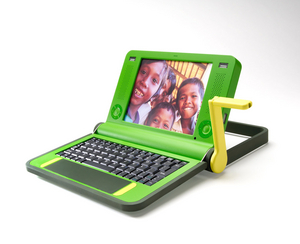One Laptop per Child
The MIT Media Lab has launched a new research initiative to develop a $100 laptop—a technology that could revolutionize how we educate the world's children. To achieve this goal, a new, non-profit association, One Laptop per Child (OLPC), has been created. (See the official project website laptop.org.) Note that there is a comprehensive description of the project in the Wikipedia.
The hardware
The Green Machine prototype, styled by Design Continuum, was unveiled at WSIS, Tunisia by UN Secretary-General Kofi Annan and Nicholas Negroponte.
Fuse-product has developed some recent prototypes: the Blue Machine and the Yellow Machine.
We are also zeroing in on the hardware specification for the first generation machine.
The software
We are committed to the principle of Open Source for this project. Please refer to our manifesto: OLPC on open source software.
Developing software for this machine is very straight forward, though there are development issues you should be aware of. Our partner in software development is Red Hat. There is a Fedora Project for OLPC, where you can get the software and join mailing lists.
We have begun an OLPC software task list. Please help us refine this list.
Discussion of Instant Messaging Challenges lays a framework for thinking about the different challenges facing the use of instant messaging applications as they exist today on the $100 laptop. Those issues will need to be overcome if instant messaging is to be usable within the environments in which the $100 laptop will be deployed.
Discussion of eBook feature set is a page in which traditional and nontraditional features are discussed both in abstract and in relation to the different eBook readers out there.
Educational content
OLPC is based on "constructionist" theories of learning pioneered by Seymour Papert and later Alan Kay, as well as the principles expressed in Nicholas Negroponte's book 'Being Digital'. Some background on our approach can be gleaned from David Cavallo's essay, "Models for growth—towards fundamental change in learning environments".
Launch plans
The laptops will be sold to governments and issued to children by schools on a basis of "one laptop per child." Initial discussions have been held with China, India, Brazil, Argentina, Egypt, Nigeria, and Thailand. In addition, a modest allocation of machines will be used to seed developer communities in a number of other countries. A commercial version of the machine will be explored in parallel.
There are a series of pages in this wiki dedicated to OLPC Thailand. Similar pages from other potential launch countries (OLPC Brasil, OLPC Argentina, OLPC Egypt, OLPC Nigeria, OLPC India, OLPC China, and OLPC Massachusetts) will follow.
Getting involved
There is a page in this wiki dedicated to Getting involved in OLPC and an OLPC Idea Pool.
FAQ
The official FAQ is on the project website, but please feel free to pose additional questions here: OLPC FAQ.
Myths
Seperated by "False" and "Falsehood" (inaccuracies) misunderstandings.
- The laptop does not have internal storage such as a hard drive. False: The laptop has 500MB of internal Flash memory similar to the inexpensive thumb drives sold at many computer stores. Operating systems can be installed and/or files can be saved on devices such as these. The laptop has USB ports for external hard drives for instance. So the internal Flash storage can be used for the OS and some file storage and external USB drives can take up the slack if needed.
- The laptop isn't powerful enough to run modern 3D games and other resource heavy programs such as video editing software. Falsehood: That's not the purpose of this laptop. It is designed to be an inexpensive way for people of limited means to use a computer for such things as internet and simple educational software.
- You're expecting this to be a magic bullet for poverty. False: Not at all. It is simply a tool for education and communication and only helps, in part, the entirety of aid programs in places where this is meant to be used.
- An old Pentium laptop can do the same thing. False: The point of this laptop is to keep people connected with the modern computer net based society. Using a laptop that may be broken or on its way out to obsolescence from a second hand store or building new much more expensive Pentium laptops just for this purpose simply isn't feasable. You have to design something specifically to answer all the requirements of a $100 laptop. One of them being that the laptop must cost $100 and be a capable and modern laptop. If we could make a $2 laptop that is modern and can do everything required of it in our program, you can bet we would make such a laptop after we've figured out how to make such a laptop.
- You're forcing this on poverty stricken areas that need food, water and housing rather than a laptop. Falsehood: Not at all. Like it was said earlier, this is only a tool and should not be seen as much more than that. We agree that other more urgent matters must be attended to before you insert high technology into the situation of poverty. But we also believe education and communication with the modern world to be important as well. Food, water, clothing as well as other necessities of life are first and foremost of absolute import. A world view and good education can do wonders for a child's mind and continued health.
- This isn't a laptop. This is a gadget. Falsehood: Point being? Even if it were a simple "gadget" that some consider less than what a laptop should be, does that change the capabilities of it? We do not think it does. Can a commercially available PDA do better? At this price, highly unlikely. Can a cell phone do better? Why waste a more than capable cell phone that may not have the needed features or may come in pieces and peripherals before it can be used on a fruitless effort to better our efforts? This is not to say that others can't come up with better ideas. We encourage it.
- Bill Gates knows what he is talking about when he mocks your laptop. False: He's welcome to give us constructive input in any form be it technology, funding or simply ideas he may have, but we're not seeing this as being currently true. Point being, he's not a deciding factor anymore or since on what direction this project will take. He seems to be as misinformed as many other detractors looking for only faults in this program.


